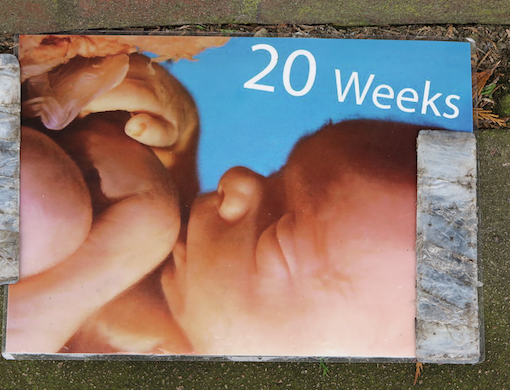Mattock Lane in Ealing, West London is a leafy, quiet, mostly-residential street with solid, detached Victorian and Edwardian houses. Dog walkers, mothers with strollers, kids with heavily laden backpacks, designer-clad joggers and groups of teenagers glued to their iphones, head into Walpole Park, a 28 acre haven of wildlife, ornamental ponds and historic buildings. Flocks of squawking rose-necked parakeets fly overhead. English ivies, lavender and hebes are planted in neat bunches in generous sized gardens. Everything seems very properly suburban and ordinary. In fact, Ealing is often referred to as “the queen of the suburbs.” And yet here on Mattock Lane, there is a Marie Stopes clinic that has just become an important part of abortion history in Great Britain.
In October 2017 Sister Supporter, a pro-choice organisation founded by local residents, presented Ealing Council with a dossier of evidence of harassment, including photographs, video, audio and written witness statements and petitioned Ealing Council to put an end to the anti-abortion protests outside the clinic. After months of public consultations and exploring a range of options, Ealing Council’s cabinet voted unanimously in favour of creating a safe zone around the clinic.
In spite of an escalation in aggressive anti-abortion activity directly outside clinics throughout the country, where many protesters bear large banners of dismembered foetuses, distribute leaflets containing misleading information about abortion, and film, follow and question women as they enter or leave the centres, nowhere else in the country has a buffer zone been set up to protect an abortion clinic, its staff and its clients.
Upon hearing the Council’s news, Richard Bentley, Managing Director at Marie Stopes UK, said: “This was never about protest. It was about small groups of strangers choosing to gather by our entrance gates where they could harass and intimidate women and try to prevent them from accessing healthcare to which they are legally entitled. Ealing Council has sent a clear message that this kind of behaviour should not be tolerated, and that these groups have no justification for trying to involve themselves in one of the most personal decisions a woman can make.”
Now, neither pro-life nor pro-choice activists are allowed to protest near the clinic, although there is a small “designated area” inside a patch of grass, roughly 100m from the clinic where members of represented groups will be able to carry out protests and vigils in order to preserve freedom of speech. Their activities, however, will be subject to several restrictions.
The establishment of this buffer zone came into effect on 23rd April and will be in force for the next three years, with a review of its effectiveness after six months. It is expected that this order by the council will protect women and their partners from hounding and harrying and emotional manipulation whilst accessing services for sexual health and contraception advice, the morning-after pill, chlamydia testing kits, vasectomies and abortions. It is also hoped that the order will allow clinic staff to do their work without being bullied and intimidated, and that it will shield local residents from disruption, distress and disquiet to their everyday lives caused by the daily protests over two decades.
On one level this action by Ealing Council is considered a momentous megastep. On other levels, however, it is still just a small step. As the Council made clear, the setting up of a “designated area” was done in order to balance the right to protest with the right of women to obtain advice and treatment in confidence, without having to pass through a barrier of harassment. Since anyone entering or leaving the clinic is within sight of the “designated area” and the “designated area” remains within the immediate neighbourhood, there have been concerns that this order might not be the hoped-for panacea. In addition, as soon as the order went into effect, some anti-abortion campaigners breached the order claiming the council had “revoked freedom of expression” while other anti-abortion campaigners filed a challenge with the High Court saying the establishment of a buffer zone outside the clinic violates the human rights of Ealing residents.
Because they feel that the government has a duty to provide all women with the same level of protection that will now be offered in Ealing, the British Pregnancy Advisory Service (BPAS) has called for urgent legislation to implement buffer zones throughout the country. BPAS is not alone in calling for national buffer zones. The Royal College of Obstetricians and Gynaecologists, the British Medical Association, Rape Crisis England and Wales, the Royal College of Midwives, Marie Stopes International, Mumsnet and Violence Against Women, amongst many other organisations and medical bodies are also calling for national buffer zones in order to ensure that women using abortion services are not approached unsolicited, and that activities designed to cause distress—eg filming and strewing the pathway with pictures or models of foetuses—are prevented.
Echoing these views, a member of Sister Supporter tells me “now that we have had one success with Ealing, it is vital to get national legislation so that all pregnancy advisory bureaux and clinics gain equal protection against anti-abortion protests.”
Following on from Ealing’s decision to establish this buffer zone, other councils around the country are now considering taking similar action and the Home Office is reviewing abortion clinic protests and whether there should be national buffer zones. Anna Veglio-White, the founder of Sister Supporter, told me “We firmly believe this will have a domino effect across the country and we look forward to the results of the nationwide review on intimidation and harassment outside abortion clinics. Now, it's up to the government to follow in Ealing's inspirational footsteps. The people of Ealing spoke up to end gender-based harassment, and our voices were heard.” Whether the order will pave the way as a model for other councils across the country and beyond remains to be seen.
While legally setting up buffer zones outside all abortion clinics is a step in the right direction, there are other steps that also need to be taken in order to establish a more humane law.
The 1967 Abortion Act, while saving some women from needing to access dangerous DIY back street abortions, did not actually decriminalise abortion in the UK—it only made it legal when two doctors authorise the procedure on specific grounds—meaning that abortion still remains within the criminal law, separated and stigmatised. Additionally, unlike other parts of the UK, the 1967 Abortion Act does not extend to Northern Ireland where abortions are only allowed if a woman's life is at risk or there is a permanent or serious risk to her physical or mental health. According to a UN committee (Cedaw), the abortion ban in Northern Ireland violates the rights of women and girls and constitutes gender-based violence that may amount to torture or cruel, inhuman or degrading treatment to women. Fatal foetal abnormalities and rape and incest, even when the victims are children (Cedaw), are not legitimate reasons for abortions. And, anyone who unlawfully has an abortion or helps carry out an abortion could theoretically be jailed for life—the harshest criminal penalty for abortion anywhere in Europe.
Since Downing Street is unwilling to step into this issue for fear of alienating the socially conservative DUP, whose support they rely on to stay in power, and Northern Irish lawmakers cannot address this issue until they form a functioning government—which they have not had for more than a year due to political deadlock—it is possible that abortion rights are a long way off.
On the other hand, after Northern Ireland’s neighbour, the Republic of Ireland, recently voted overwhelmingly to overturn its abortion ban by 66 per cent to 34 per cent, Sinn Fein party conference delegates in Belfast voted in favour of liberalising the draconian abortion law, saying the procedure should be provided through a GP-led service for a “limited gestational period.” And perhaps even more importantly, voters may be more open to changing abortion laws than their political parties are. Back in 2016, a study by Amnesty International found that nearly 75 per cent of those surveyed supported making abortion available in cases of rape, incest, or fatal fetal anomalies while nearly 60 percent supported decriminalising abortion for all woman and medical personal. Clearly, public attitudes support a change in an outdated law.
Creating a buffer zone around an abortion clinic in west London, watching close neighbours overturn iron-fisted abortion laws, overwhelming public support for abortion rights; will these actions eventually lead to a more humane law for all women and girls and a total decriminalisation of abortion? Time will tell.













